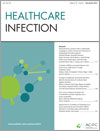
Healthcare Infection
Volume 19 Number 4 2014
HI14024Improvements in process with a multimodal campaign to reduce urinary tract infections in hospitalised Australian patients
The majority of urinary tract infections (UTIs) in hospitalised patients are associated with indwelling urinary catheters (IDCs). We evaluated the impact of an educational campaign on IDC care and the proportion of hospitalised patients with UTI, and demonstrated a reduction in UTIs but a non-sustainable improvement in clinical practices. Multimodal strategies to improve process can successfully reduce UTIs arising during hospitalisation, but strategies for sustainable quality improvement are required.
HI14031Clostridium difficile-associated disease: how much do we really know? A single institution study
The incidence and virulence of nosocomial Clostridium difficile infection (CDI) is increasing around the world. The knowledge of CDI prevention and management amongst healthcare workers was assessed at a tertiary institution. Knowledge deficiencies were identified and education would assist in arresting the rising impact of CDI.
HI14033Changes in healthcare-associated infections after the introduction of a national hand hygiene initiative
The National Hand Hygiene Initiative in Australia aimed to improve hand hygiene compliance amongst healthcare workers and so reduce healthcare-associated infections. We examined if the introduction of the initiative was associated with a change in infection rates. Understanding the effectiveness of the initiative is key to understanding if it was also cost-effective.
HI14033 Abstract | HI14033 Full Text | HI14033PDF (440 KB) | HI14033Supplementary Material (2.1 MB) Open Access Article
HI14023Prior room occupancy increases risk of methicillin-resistant Staphylococcus aureus acquisition
Understanding the risk of methicillin-resistant Staphylococcus aureus (MRSA) acquisition from prior room occupants provides valuable data to inform infection prevention strategies. We explored the risk of acquiring MRSA from prior room occupants and identified a significant risk. Increased attention to discharge room cleaning in hospitals is required and the reconsideration of additional recommendations for discharge cleaning.
HI14023 Abstract | HI14023 Full Text | HI14023PDF (224 KB) Open Access Article
HI14019Approaches to surveillance of Staphylococcus aureus bacteraemia and Clostridium difficile infection in Australian states and territories
Surveillance of healthcare-associated infection (HAI) is aimed at improving patient safety, decreasing HAI rates, and reducing morbidity and mortality. This article reports on a survey conducted by the Australian Commission on Safety and Quality in Health Care during 2012–13. It describes approaches to surveillance of Staphylococcus aureus bacteraemia (SAB) and Clostridium difficile infection (CDI) by Australian states and territories for collection, validation and reporting of SAB and CDI data; and identifies differences in practices.

